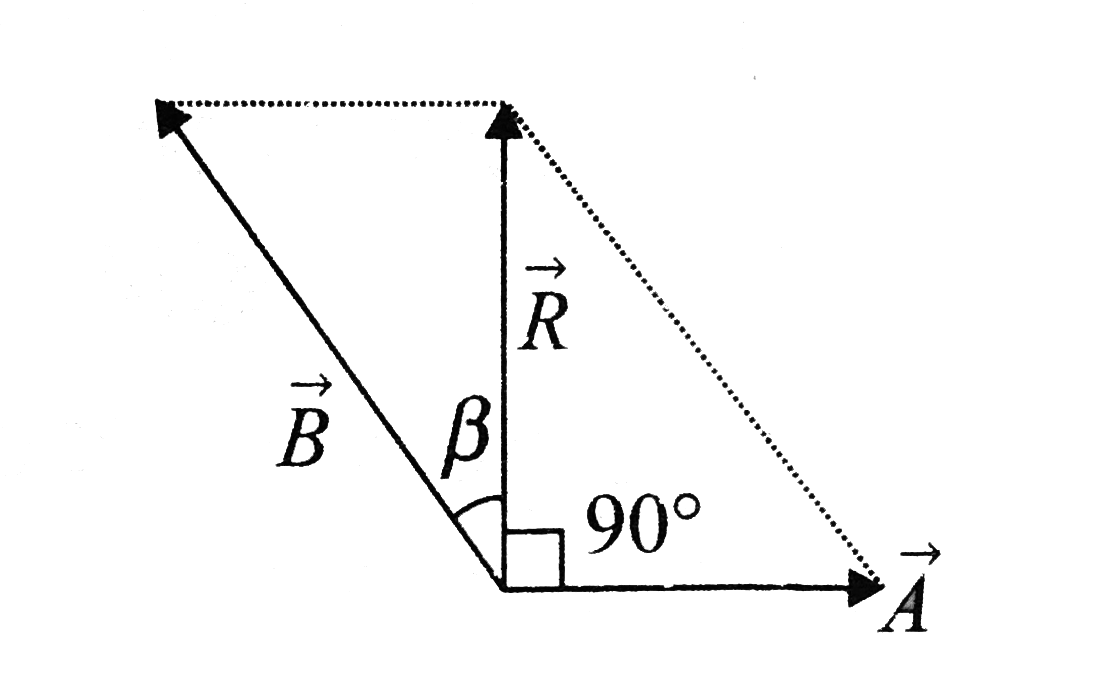The resultant and dot product of two vectors →aand→b is equal to the magnitude of →a. Show that when the vector →a is doubled , the new resultant is perpendicular to →b .
To solve the problem, we need to show that when vector →A is doubled, the new resultant vector is perpendicular to vector →B. We start with the given condition that the resultant and dot product of vectors →A and →B is equal to the magnitude of vector →A.
Step 1: Understand the given condition
We are given:
|→A+→B|=|→A|
This means that the magnitude of the resultant vector →A+→B is equal to the magnitude of vector →A.
Step 2: Square both sides
To eliminate the square root, we square both sides:
|→A+→B|2=|→A|2
Using the property of magnitudes, we can expand the left-hand side:
(→A+→B)⋅(→A+→B)=→A⋅→A
This simplifies to:
→A⋅→A+2→A⋅→B+→B⋅→B=→A⋅→A
Step 3: Cancel out →A⋅→A
Now, we can cancel →A⋅→A from both sides:
2→A⋅→B+→B⋅→B=0
Step 4: Rearrange the equation
Rearranging gives us:
2→A⋅→B=−→B⋅→B
Step 5: Analyze the dot product
Since →B⋅→B is always non-negative (it represents the square of the magnitude of →B), the left side 2→A⋅→B must also be non-positive. This implies:
→A⋅→B=0
Thus, vectors →A and →B are perpendicular.
Step 6: Doubling vector →A
Now, we consider the new vector 2→A. We need to show that:
(2→A)⋅→B=0
Calculating this gives:
(2→A)⋅→B=2(→A⋅→B)=2⋅0=0
Thus, 2→A is also perpendicular to →B.
Conclusion
We have shown that when vector →A is doubled, the resultant vector 2→A is perpendicular to vector →B.
We are given:
|→A+→B|=|→A|
This means that the magnitude of the resultant vector →A+→B is equal to the magnitude of vector →A.
To eliminate the square root, we square both sides:
|→A+→B|2=|→A|2
Using the property of magnitudes, we can expand the left-hand side:
(→A+→B)⋅(→A+→B)=→A⋅→A
This simplifies to:
→A⋅→A+2→A⋅→B+→B⋅→B=→A⋅→A
Now, we can cancel →A⋅→A from both sides:
2→A⋅→B+→B⋅→B=0
Rearranging gives us:
2→A⋅→B=−→B⋅→B
Since →B⋅→B is always non-negative (it represents the square of the magnitude of →B), the left side 2→A⋅→B must also be non-positive. This implies:
→A⋅→B=0
Thus, vectors →A and →B are perpendicular.
Now, we consider the new vector 2→A. We need to show that:
(2→A)⋅→B=0
Calculating this gives:
(2→A)⋅→B=2(→A⋅→B)=2⋅0=0
Thus, 2→A is also perpendicular to →B.
We have shown that when vector →A is doubled, the resultant vector 2→A is perpendicular to vector →B.
Topper's Solved these Questions
- VECTORS SCALARS ELEMENTARY CALCULUS Book:ICSEChapter:VECTORS SCALARS ELEMENTARY CALCULUS Exercise:ADDITIONAL SOLVED PROBLEMS
Explore 22 Videos
- VECTORS SCALARS ELEMENTARY CALCULUS Book:ICSEChapter:VECTORS SCALARS ELEMENTARY CALCULUS Exercise:EXAMPLES
Explore 26 Videos
- UNITSBook:ICSEChapter:UNITSExercise:MODULE 3 (SELECTED PROBLEMS)
Explore 38 Videos
- WAVESBook:ICSEChapter:WAVESExercise:From Musical Sound
Explore 10 Videos
Similar Questions
The resultant of two vectors →P and →Q is →R. If →Q is doubled then the new resultant vector is perpendicular to →P. Then magnitude of →R is :-
View SolutionWhat are the properties fo two vectors →aand→b such that →a+→b=→a−→b ?
View SolutionThe resultant of two vectors →A and →B is perpendicular to the vector →A and its magnitudes is equal to half of the magnitudes of vector →B (figure). The angle between →A and →B is

View SolutionTwo vectors →A and →B have equal magnitudes . If magnitude of →A+→B is equal to n× the magnitude of →A−→B , then the angle between →A and →B is
View SolutionIf two vectors →aand→b are such that ∣∣→a.→b∣∣=∣∣→a×→b∣∣, then find the angle the vectors →aand→b
View SolutionIf a vector →A is parallel to another vector →B then the resultant of the vector →A×→B will be equal to
View Solutiona, b are the magnitudes of vectors →a & →b. If →a×→b=0 the value of →a.→b is
View SolutionIf →aand→b are two vector such that ∣∣→a+→b∣∣=|→a|, then show that vector |2a+b| is perpendicular to →b.
View SolutionTwo vectors →Aand→B lie in plane, another vector →C lies outside this plane, then the resultant of these three vectors i.e., →A+→B+→C
View SolutionIf →a,→b are two vectors such that ∣∣→a+→b∣∣=∣∣→b∣∣, then prove that →a+2→b is perpendicular to →a .
View Solution

